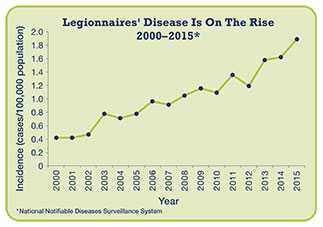For Media
Listed below are answers to common background questions that reporters have about legionellosis. Contact CDC’s Media Relations office with additional questions.
Questions and Answers
Q: Is legionellosis (Legionnaires’ disease and Pontiac fever) reportable?
A: Yes, legionellosis is a nationally notifiable disease. Lab-confirmed cases of legionellosis should be reported to state health departments, who are to notify CDC. The local or state health department where a patient lives or an outbreak is occurring is the best source of information about specific cases or situations. However, health departments usually release very limited information about cases in order to protect the privacy of those affected.
Q: Can CDC confirm if there are legionellosis cases in my state?
A: Your local or state health department has the most up-to-date information about legionellosis cases in your state. Unless CDC has been contacted by the health department, we are unlikely to be immediately aware of local cases. However, we can answer questions about legionellosis in general.
The Morbidity and Mortality Weekly Reports contain available data by state of all notifiable diseases. Preliminary data from 2016, which includes data about legionellosis, can be found here. Each week, cases of legionellosis are reported to CDC and published here.
Q: When does CDC get involved in responding to outbreaks of Legionnaires’ disease or Pontiac fever?

In the United States, reported cases of Legionnaires’ disease have grown by nearly four and a half times since 2000.
It is unclear whether this increase represents artifact (due to increased awareness and testing), increased susceptibility of the population, increased Legionella in the environment, or some combination of factors.
A: State public health officials typically invite CDC to assist with an investigation when additional expertise, capacity, or resources are needed. For information about a current outbreak, contact the state or local health department where the outbreak is occurring. For cruise ship outbreaks involving U.S. citizens and ports of call in the United States, CDC has jurisdiction over the response. Visit CDC’s Vessel Sanitation Program website for more information.
Q: How common is Legionnaires’ disease?
A: About 6,000 cases of Legionnaires’ disease were reported in the United States in 2015. However, because Legionnaires’ disease is likely underdiagnosed, this number may underestimate the true incidence.
For additional information about legionellosis, see CDC’s About the Disease website.
Q: Is Legionnaires’ disease on the rise?
A: In general, the number of cases reported to CDC has been on the rise since 2000. This may reflect a true increase in the frequency of disease due to a number of factors (e.g., older U.S. population, more at-risk individuals, aging plumbing infrastructure, climate). It may also be in part a result of increased use of diagnostic testing or better reporting.
Q: Where does Legionnaires’ disease occur most often in the United States?
A: The rate of reported legionellosis cases tends to be higher in the northeast and midwest than in the south and west. Researchers are not certain why that is, but it is likely related to a combination of factors.
- Page last reviewed: June 1, 2017
- Page last updated: June 1, 2017
- Content source:


 ShareCompartir
ShareCompartir